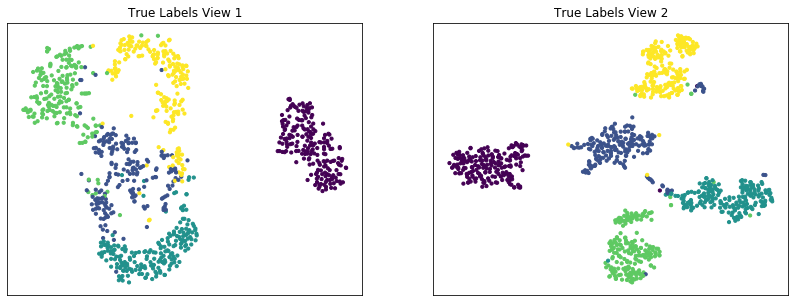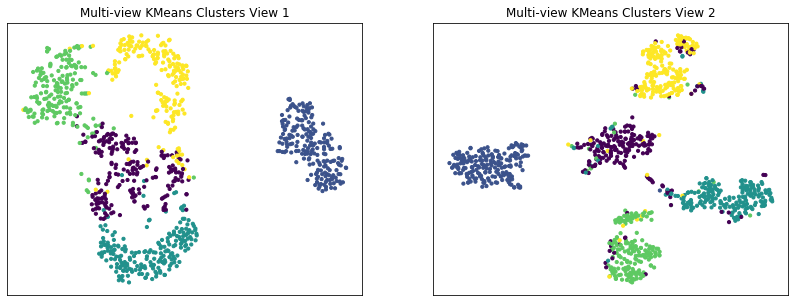None
Multi-view Spherical KMeans¶
Note, this tutorial compares performance against the SphericalKMeans function from the spherecluster package which is not a installed dependency of mvlearn.
[1]:
!pip3 install spherecluster==0.1.7
from mvlearn.datasets import load_UCImultifeature
from mvlearn.cluster import MultiviewSphericalKMeans
from spherecluster import SphericalKMeans
import numpy as np
from sklearn.manifold import TSNE
from sklearn.metrics import normalized_mutual_info_score as nmi_score
import matplotlib.pyplot as plt
import warnings
warnings.simplefilter('ignore') # Ignore warnings
%matplotlib inline
Requirement already satisfied: spherecluster==0.1.7 in /home/alex/MLenv/lib/python3.6/site-packages (0.1.7)
Requirement already satisfied: scipy in /home/alex/MLenv/lib/python3.6/site-packages (from spherecluster==0.1.7) (1.3.1)
Requirement already satisfied: pytest in /home/alex/MLenv/lib/python3.6/site-packages (from spherecluster==0.1.7) (5.2.1)
Requirement already satisfied: numpy in /home/alex/MLenv/lib/python3.6/site-packages (from spherecluster==0.1.7) (1.18.1)
Requirement already satisfied: scikit-learn>=0.20 in /home/alex/MLenv/lib/python3.6/site-packages (from spherecluster==0.1.7) (0.21.3)
Requirement already satisfied: nose in /home/alex/MLenv/lib/python3.6/site-packages (from spherecluster==0.1.7) (1.3.7)
Requirement already satisfied: importlib-metadata>=0.12; python_version < "3.8" in /home/alex/MLenv/lib/python3.6/site-packages (from pytest->spherecluster==0.1.7) (0.23)
Requirement already satisfied: atomicwrites>=1.0 in /home/alex/MLenv/lib/python3.6/site-packages (from pytest->spherecluster==0.1.7) (1.3.0)
Requirement already satisfied: py>=1.5.0 in /home/alex/MLenv/lib/python3.6/site-packages (from pytest->spherecluster==0.1.7) (1.8.0)
Requirement already satisfied: packaging in /home/alex/MLenv/lib/python3.6/site-packages (from pytest->spherecluster==0.1.7) (19.2)
Requirement already satisfied: more-itertools>=4.0.0 in /home/alex/MLenv/lib/python3.6/site-packages (from pytest->spherecluster==0.1.7) (7.2.0)
Requirement already satisfied: attrs>=17.4.0 in /home/alex/MLenv/lib/python3.6/site-packages (from pytest->spherecluster==0.1.7) (19.2.0)
Requirement already satisfied: wcwidth in /home/alex/MLenv/lib/python3.6/site-packages (from pytest->spherecluster==0.1.7) (0.1.7)
Requirement already satisfied: pluggy<1.0,>=0.12 in /home/alex/MLenv/lib/python3.6/site-packages (from pytest->spherecluster==0.1.7) (0.13.0)
Requirement already satisfied: joblib>=0.11 in /home/alex/MLenv/lib/python3.6/site-packages (from scikit-learn>=0.20->spherecluster==0.1.7) (0.14.1)
Requirement already satisfied: zipp>=0.5 in /home/alex/MLenv/lib/python3.6/site-packages (from importlib-metadata>=0.12; python_version < "3.8"->pytest->spherecluster==0.1.7) (0.6.0)
Requirement already satisfied: pyparsing>=2.0.2 in /home/alex/MLenv/lib/python3.6/site-packages (from packaging->pytest->spherecluster==0.1.7) (2.3.0)
Requirement already satisfied: six in /home/alex/MLenv/lib/python3.6/site-packages (from packaging->pytest->spherecluster==0.1.7) (1.11.0)
WARNING: You are using pip version 19.3.1; however, version 20.1 is available.
You should consider upgrading via the 'pip install --upgrade pip' command.
/home/alex/MLenv/lib/python3.6/site-packages/sklearn/externals/joblib/__init__.py:15: DeprecationWarning: sklearn.externals.joblib is deprecated in 0.21 and will be removed in 0.23. Please import this functionality directly from joblib, which can be installed with: pip install joblib. If this warning is raised when loading pickled models, you may need to re-serialize those models with scikit-learn 0.21+.
warnings.warn(msg, category=DeprecationWarning)
Load in UCI digits multiple feature dataset as an example¶
[2]:
RANDOM_SEED=5
# Load dataset along with labels for digits 0 through 4
n_class = 5
data, labels = load_UCImultifeature(select_labeled = list(range(n_class)))
# Just get the first two views of data
m_data = data[:2]
Creating a function to display data and the results of clustering¶
[3]:
def display_plots(pre_title, data, labels):
# plot the views
plt.figure()
fig, ax = plt.subplots(1,2, figsize=(14,5))
dot_size=10
ax[0].scatter(data[0][:, 0], data[0][:, 1],c=labels,s=dot_size)
ax[0].set_title(pre_title + ' View 1')
ax[0].axes.get_xaxis().set_visible(False)
ax[0].axes.get_yaxis().set_visible(False)
ax[1].scatter(data[1][:, 0], data[1][:, 1],c=labels,s=dot_size)
ax[1].set_title(pre_title + ' View 2')
ax[1].axes.get_xaxis().set_visible(False)
ax[1].axes.get_yaxis().set_visible(False)
plt.show()
Multi-view spherical KMeans clustering on 2 views¶
Here we will compare the performance of the Multi-view and Single-view versions of spherical kmeans clustering. We will evaluate the purity of the resulting clusters from each algorithm with respect to the class labels using the normalized mutual information metric.
As we can see, Multi-view clustering produces clusters with slightly higher purity compared to those produced by clustering on just a single view or by clustering the two views concatenated together.
[4]:
#################Single-view spherical kmeans clustering#####################
# Cluster each view separately
s_kmeans = SphericalKMeans(n_clusters=n_class, random_state=RANDOM_SEED)
s_clusters_v1 = s_kmeans.fit_predict(m_data[0])
s_clusters_v2 = s_kmeans.fit_predict(m_data[1])
# Concatenate the multiple views into a single view
s_data = np.hstack(m_data)
s_clusters = s_kmeans.fit_predict(s_data)
# Compute nmi between true class labels and single-view cluster labels
s_nmi_v1 = nmi_score(labels, s_clusters_v1)
s_nmi_v2 = nmi_score(labels, s_clusters_v2)
s_nmi = nmi_score(labels, s_clusters)
print('Single-view View 1 NMI Score: {0:.3f}\n'.format(s_nmi_v1))
print('Single-view View 2 NMI Score: {0:.3f}\n'.format(s_nmi_v2))
print('Single-view Concatenated NMI Score: {0:.3f}\n'.format(s_nmi))
#################Multi-view spherical kmeans clustering######################
# Use the MultiviewSphericalKMeans instance to cluster the data
m_kmeans = MultiviewSphericalKMeans(n_clusters=n_class, random_state=RANDOM_SEED)
m_clusters = m_kmeans.fit_predict(m_data)
# Compute nmi between true class labels and multi-view cluster labels
m_nmi = nmi_score(labels, m_clusters)
print('Multi-view NMI Score: {0:.3f}\n'.format(m_nmi))
Single-view View 1 NMI Score: 0.631
Single-view View 2 NMI Score: 0.730
Single-view Concatenated NMI Score: 0.730
Multi-view NMI Score: 0.823
Plots of clusters produced by multi-view spectral clustering and the true clusters¶
We will display the clustering results of the Multi-view kmeans clustering algorithm below, along with the true class labels.
[5]:
# Running TSNE to display clustering results via low dimensional embedding
tsne = TSNE()
new_data_1 = tsne.fit_transform(m_data[0])
new_data_2 = tsne.fit_transform(m_data[1])
new_data = [new_data_1, new_data_2]
[6]:
display_plots('True Labels', new_data, labels)
display_plots('Multi-view KMeans Clusters', new_data, m_clusters)
<Figure size 432x288 with 0 Axes>

<Figure size 432x288 with 0 Axes>

Multi-view spherical KMeans clustering different parameters¶
Here we will again compare the performance of the Multi-view and Single-view versions of spherical kmeans clustering on data with 2 views. We will follow a similar procedure as before, but we will be using a different configuration of parameters for Multi-view Spherical KMeans Clustering.
Again, we can see that Multi-view clustering produces clusters with slightly higher purity compared to those produced by clustering on just a single view or by clustering the two views concatenated together.
[7]:
#################Single-view spherical kmeans clustering#####################
# Cluster each view separately
s_kmeans = SphericalKMeans(n_clusters=n_class, random_state=RANDOM_SEED)
s_clusters_v1 = s_kmeans.fit_predict(m_data[0])
s_clusters_v2 = s_kmeans.fit_predict(m_data[1])
# Concatenate the multiple views into a single view
s_data = np.hstack(m_data)
s_clusters = s_kmeans.fit_predict(s_data)
# Compute nmi between true class labels and single-view cluster labels
s_nmi_v1 = nmi_score(labels, s_clusters_v1)
s_nmi_v2 = nmi_score(labels, s_clusters_v2)
s_nmi = nmi_score(labels, s_clusters)
print('Single-view View 1 NMI Score: {0:.3f}\n'.format(s_nmi_v1))
print('Single-view View 2 NMI Score: {0:.3f}\n'.format(s_nmi_v2))
print('Single-view Concatenated NMI Score: {0:.3f}\n'.format(s_nmi))
#################Multi-view spherical kmeans clustering######################
# Use the MultiviewSphericalKMeans instance to cluster the data
m_kmeans = MultiviewSphericalKMeans(n_clusters=n_class,
n_init=10, max_iter=6, patience=2, random_state=RANDOM_SEED)
m_clusters = m_kmeans.fit_predict(m_data)
# Compute nmi between true class labels and multi-view cluster labels
m_nmi = nmi_score(labels, m_clusters)
print('Multi-view NMI Score: {0:.3f}\n'.format(m_nmi))
Single-view View 1 NMI Score: 0.631
Single-view View 2 NMI Score: 0.730
Single-view Concatenated NMI Score: 0.730
Multi-view NMI Score: 0.684